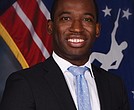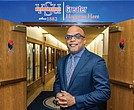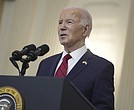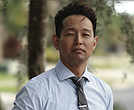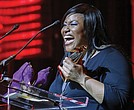Collaboration helps erase graffiti at historic cemeteries
George Copeland Jr. | 8/20/2020, 6 p.m.
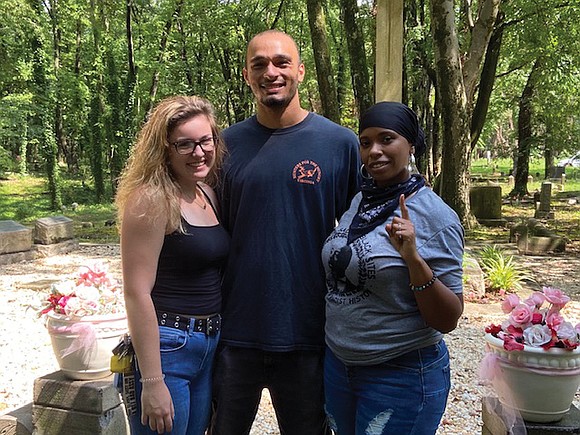
Nearly three weeks after historical African- American and Jewish cemeteries were tagged with graffiti, volunteers and other workers have cleaned the marks — “777” — that were spraypainted on headstones and entrances to Evergreen, East End, Barton Heights and Sir Moses Montefiore cemeteries, including the gravesite of noted businesswoman Maggie L. Walker.
Queen Richardson, an activist with the group One Sound Movement, is one of the volunteers who, along with friends, helped erase the graffiti at Sir Moses Montefiore Cemetery in Fulton. The historic Jewish cemetery was started by orthodox Jewish immigrants in 1886.
Ms. Richardson and the group surprised cemetery officials by showing up to help remove the numeric symbols that the Anti-Defamation League said had been appropriated by the Nazis and more recently used by white supremacist groups.
Ms. Richardson has been an active participant in rallies and demonstrations around the Lee statue, or what some protesters are calling Marcus-David Peters Circle. By volunteering at the cemetery, Ms. Richardson said she and her friends wanted “to show that we just didn’t stand for what was going on.”
John Sydnor, executive director of the Enrichmond Foundation that manages historic Evergreen Cemetery where Mrs. Walker is buried, said volunteers similarly helped at the other affected grave sites.
He said officials with the Virginia Department of Historic Resources were present at Evergreen Cemetery to educate an eager crowd of 17 volunteers, including members of the Jewish Community Federation of Richmond, on how to clean affected areas without damaging the property or grave sites.
“It was an opportunity to rally around the folks who are protecting and preserving these sacred sites,” Mr. Sydnor said.
These instances of communities connecting and collaborating will continue, Mr. Sydnor said. The close proximity of Sir Moses Montefiore Cemetery to Evergreen Cemetery is seen as an opportunity for greater communication in the future, he said.
Mr. Sydnor also noted that the Jewish cemetery is part of Enrichmond’s two-year master plan as a potential collaborator in efforts to improve the state of the historic cemetery by installing a park trail they’re aiming to bring close to the site.
Beyond greater collaboration and inclusivity, work is moving along quickly on plans to prevent future acts of vandalism, Mr. Sydnor said.
Ms. Richardson, for her part, is developing ideas for ways concerned citizens can help keep these cemeteries safe and secure, but she said she has not shared them yet with officials.
Those interested in safeguarding the sites may have their work cut out for them. As detailed by David L. Cohen, director of community relations for JCFR, there are many challenges to be address, from the cemeteries' isolation from surrounding communities to the frequency of these acts and others. Mr. Cohen said multiple incidents of harassment were reported by members of the Jewish community in the months before the COVID-19 pandemic.
For their part, JCFR has responded to the vandalism at Sir Moses Montefiore Cemetery by emptying a regional security advisor to consult with local police departments, alongside coordination with the trustees that manage the cemetery and others involved with the site to ensure everyone has the details necessary during the tagging investigation.
Mr. Cohen acknowledged, however, that these acts may not entirely be prevented, though he has hope that greater advocacy for education and tolerance can create a community where such vandalism doesn’t reoccur.
This approach seems to be adopted by faith groups in Richmond’s Jewish and African-American communities and elected officials, who released a statement decrying the vandalism and stressing the importance of solidarity among the region’s Jewish and African-American population.
“In the current climate, where racial and social justice are being discussed openly in our community, these acts are designed to stoke fear in the hearts of both Jewish and Black communities,” the statement read.
“Attacks such as these are meant to remind both communities of a past where we were not welcome as full participants in the greater society. Together, we say loudly and clearly that we reject that message.
“In 2020, the arc of the moral universe is most definitely bending toward justice. Equal justice, fairness and increased inclusion are Richmond’s future. Heinous acts like this belong in its past. ...
“Hate does not discriminate, and bias and bigotry against both the Black and Jewish communities is a shared history. We are committed to a brighter future – a future that will only improve through government reforms, education, personal conviction and action. With strong bridges between our two communities, we know we can create a safer and more just Greater Richmond.”
The statement was signed by the Baptist Ministers’ Conference of Richmond and Vicinity, the JCFR, the Richmond Council of Congregational Rabbis, the Richmond and Henrico branches of the NAACP, orthodox synagogue Keneseth Beth Israel and the trustees of the Sir Moses Montefiore Cemetery and the Enrichmond Foundation, along with 10 elected officials who represent Richmond and/or Henrico in Congress, the Virginia General Assembly and in city and county government.
It’s this spirit of collaboration that Mr. Sydnor sees defining the relationship between the historic cemeteries in the future.
“That’s the combined voice that I think is going to come from this,” Mr. Sydnor said. “The ability to coordinate, communicate together and work together to make sure these sacred places are protected.”

